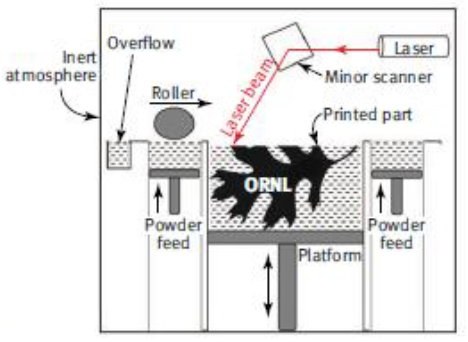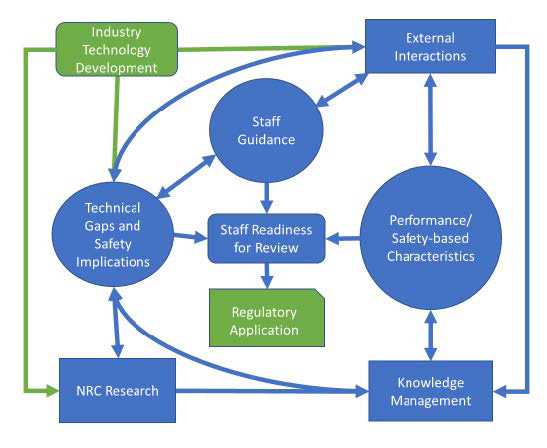On this page:
What are AMTs?
 Figure 1 Schematic of layer-by-layer nature of LPBF build process
Figure 1 Schematic of layer-by-layer nature of LPBF build processAdvanced manufacturing technologies (AMTs) include those techniques and material processing methods that have not been traditionally used in the United States (U.S.) nuclear industry and have yet to be formally standardized by the nuclear industry (e.g., through nuclear codes and standards, through a submittal, or other processes resulting in NRC approval/endorsement). AMT is used as an umbrella term to cover a broad range of novel and non-standardized manufacturing methods, and in some cases the associated raw materials. AMTs can be applied to new and replacement components, repair activities of existing components, and specific fabrication elements (i.e., welds, coatings, etc.) of a component to provide a performance or operational benefit.
Instead of inclusion in this AMT page, new manufacturing technologies for nuclear fuel or cladding applications are addressed under the NRC’s Accident Tolerant Fuel program.
NRC has focused its initial activities on five specific AMTs:
- Additive Manufacturing (AM) – Laser Powder Bed Fusion
- AM – Directed Energy Deposition (DED)
- Cold Spray
- Electron Beam (EB) welding
- Powder Metallurgy (PM) – Hot Isostatic Pressing (HIP)

Who is working on AMTs?
In May 2019, the Nuclear Energy Institute (NEI) developed a “Roadmap for Regulatory Acceptance of Advanced Manufacturing Methods in the Nuclear Energy Industry.” This roadmap provided NEI’s perspective on the AMT landscape as well as how the NRC and industry should approach AMT qualification, regulatory approval, codes and standards development, and research activities.
The U.S. Department of Energy (DOE) and the Electric Power Research Institute (EPRI) are sponsoring research at various levels of maturity to improve the understanding and demonstrate AMTs for nuclear applications. In particular, DOE and EPRI are performing a multi-year effort to demonstrate powder metallurgy-hot isostatic pressing (PM-HIP), electron beam welding, diode laser cladding, bulk additive manufacturing, and advanced machining for small modular reactor vessel manufacture and fabrication.
Meanwhile, nuclear vendors and utilities have worked to place some initial AMT components into service. In March 2020, Westinghouse and Exelon installed a thimble plugging device using stainless steel 316L made with laser powder bed fusion (LPBF) in Byron Unit 1. In April 2021, Framatome and Oak Ridge National Laboratory worked with the Tennessee Valley Authority to install four stainless steel channel fasteners fabricated by LPBF in Browns Ferry Unit 2.
What is NRC doing related to AMTs?
 Figure 2 Interactive nature of AMT Action Plan Tasks
Figure 2 Interactive nature of AMT Action Plan TasksIn SECY-18-0060, the NRC's Executive Director for Operations (EDO) indicated that to efficiently and effectively regulate new technologies, the NRC staff should: engage early with ongoing industry research; develop codes and standards that support the use of new materials and manufacturing methods while ensuring the safety of these techniques; address updates to NRC guidance documents; and conduct other appropriate activities. From interactions with stakeholders, the NRC recognized that the nuclear industry is likely to use AMTs in applications that require regulatory oversight. Consistent with the NRC mission, EDO direction, and Agency Principles of Good Regulation, the NRC developed a strategy that will enable the NRC staff to effectively, efficiently, and transparently regulate components manufactured using AMTs.
In January 2019, NRC published a draft action plan for AMTs that identified objectives, regulatory paths, key considerations and near-term tasks to help NRC prepare for AMTs.
In June 2020, Revision 1 to the NRC AMT Action Plan was published, which updated and superseded the prior draft action plan. This latest action plan identified three primary tasks, each with specific subtasks:
- Task 1: Technical Preparedness
- Subtask 1A:AMT Processes under Consideration
- Subtask 1B: Inspection and Non-Destructive Examination (NDE)
- Subtask 1C: Modeling and Simulation of Microstructure and Properties
- Task 2: Regulatory Preparedness
- Subtask 2A: Implementation using the 10 CFR 50.59 Process
- Subtask 2B: Assessment of Regulatory Guidance
- Subtask 2C: AMT Guidance Document
- Task 3: Communications and Knowledge Management
- Subtask 3A: Internal Interactions
- Subtask 3B: External Interactions
- Subtask 3C: Knowledge Management
- Subtask 3D: Public Workshop
- Subtask 3E: AMT Materials Information Course
As activities under the Rev. 1 AMT Action Plan near completion, additional NRC research and regulatory activities, workshops and public meetings are under development to maintain preparedness for industry applications of AMTs.

Figure 3 Diagram of technical reports and assessments and regulatory guidelines to support the development of AMT guidance

NRC Public Meetings Related to AMTs
NRC has consistently engaged with the public and external stakeholders through NRC-sponsored public meetings and interactions. Links to a few of the key public interactions can be found here:

Status of NRC AMT Action Plan Deliverables
| Subtask |
Actions/Deliverables |
Status |
1A AMT Processes under Consideration
TLR: Technical Letter Report
TA: Technical Assessment
DGD: Draft Guidelines Document |
Additive Manufacturing (AM) – Laser Powder Bed Fusion |
TLR and TA: complete – ML20351A292
DGD: complete – ML21074A040 |
| AM – Directed Energy Deposition (DED) |
TLR and TA: complete – ML21301A077
DGD: ML22143A951 |
| Cold Spray |
TLR and TA: complete – ML21263A105
DGD: ML22143A952 |
| Electron Beam (EB) welding |
TLR and TA: complete – ML22143A927 |
| Powder Metallurgy (PM) – Hot Isostatic Pressing (HIP) |
TLR and TA: complete – ML22164A437 |
| 1B Inspection and NDE |
NDE gap analysis |
Complete - ML20349A012 |
| 1C Modeling and Simulation of Microstructure and Properties |
Modeling and simulation gap analysis to predict microstructure |
Complete - ML20269A301 |
| Modeling and simulation gap analysis to predict material performance |
Complete - ML20350B550 |
| 2A Implementation using the 10 CFR 50.59 Process |
Final report on using the 10 CFR 50.59 process for AMTs |
Complete – ML21155A043 |
| 2B Assessment of Regulatory Guidance |
Path forward on guidance development or modification |
Complete - ML20233A693 |
| 2C AMT Guidance Document |
Public meeting on guidance concept / framework |
Public meeting held July 2020 |
| Develop a document that describes the generic technical information to be addressed in AMT submittals |
ML21074A037 - Draft AMT Review Guidelines
ML21074A040 - Draft Guidelines Document for AM - LPBF
ML22143A951 - Draft Guidelines Document for AM – LDED
ML22143A952 - Draft Guidelines Document for Cold Spray |
| Public meeting to discuss draft document |
Public meeting held September 16, 2021 |
| 3D Workshop |
Hold Public Workshop |
Meeting summary: ML20357B071
Research Information Letter: Part 1 Part 2
Workshop Website |

Page Last Reviewed/Updated Thursday, July 06, 2023